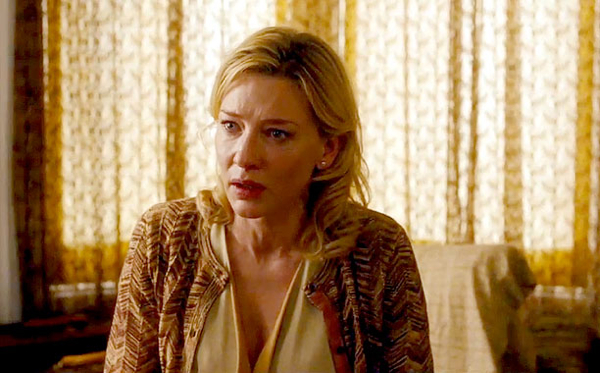Movie review by Greg Carlson
The tremendous Cate Blanchett supplies a tour-de-force performance in Woody Allen’s “Blue Jasmine,” a Blanche DuBois meets Bernie Madoff moral tale that represents one of the writer-director’s strongest and most sustained efforts since 2005’s “Match Point.” Allen’s ever-prolific late period contains more clunkers than gems, but the misfires (“To Rome with Love,” “Whatever Works”) haven’t tarnished the delights (“Midnight in Paris,” “Vicky Cristina Barcelona”). “Blue Jasmine” doesn’t surpass “Crimes and Misdemeanors,” perhaps Allen’s finest exploration of the psyche’s darkest corners, but the new film is a worthy addition to the filmmaker’s oeuvre.
Blanchett appeared as DuBois in the Sydney Theatre Company’s revival of “A Streetcar Named Desire” (performed in 2009 at the Brooklyn Academy of Music) and many commentators have drawn comparisons between Tennessee Williams’ tipsy, fading belle and Jeanette “Jasmine French” Francis, Allen’s richly imagined hothouse flower. While the “Streetcar” allusions in “Blue Jasmine” can keep Williams aficionados busy – see Manohla Dargis’ review in “The New York Times” for a thorough account – Allen has shaped the homage into a stern portrait of desperation both loud and quiet.
Miraculously, Blanchett wills the elitist, entitled Jasmine into spaces of pathos and vulnerability. The fallen Park Avenue socialite’s doomed marriage with a swindling financier (Alec Baldwin) has left her without means and a place to live. After fleeing New York for San Francisco to crash with her sister Ginger (Sally Hawkins), Jasmine’s sense of privilege collides with the working class world inhabited by her sibling, a grocery clerk whose boyfriend, an auto mechanic named Chili (Bobby Cannavale), deeply resents the needy Jasmine’s inconvenient imposition. Jasmine’s plans to rediscover herself are by turns pathetic and misguided, and Allen nails the clash of classes in a series of jittery outbursts and cruel recriminations.
Allen explores a number of his pet themes, including self-delusion, wealth, opportunity, greed, and the fallout from amour fou. The fortunes and misfortunes of both Jasmine and Ginger are examined in detail, and Allen includes numerous flashbacks to explain Jasmine’s precarious and deteriorating mental health. Even though both blue and white collar stereotypes abound in the outward appearances of the film’s inhabitants, Allen wisely withholds judgment on his players, allowing the viewer to understand the motives of all significant parties, most of whom make poor decisions at one point or another. Along with Hawkins, Baldwin, and Cannavale, support is provided by Andrew Dice Clay, Louis C.K., Michael Stuhlbarg, and Peter Sarsgaard.
“Blue Jasmine” belongs to Blanchett, however, and although it’s far too early to make award season predictions, nobody would be surprised if she earns an emphatic series of accolades later this year for her work as Jasmine, a role David Denby has called “the most complicated and demanding performance of her movie career.” Allen currently holds the record among living filmmakers for directing the most Oscar-winning performances (six total, five by women), so it is little wonder that actors seek opportunities to appear in his movies. Blanchett, like Dianne Wiest before her, makes room for humor while striking the perfect notes of seriousness and sadness. By the time we join Jasmine on a park bench in the movie’s stirring coda, she has become very difficult to forget.
